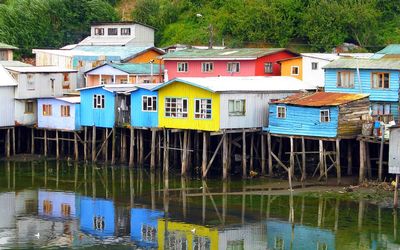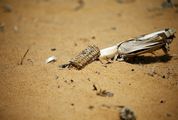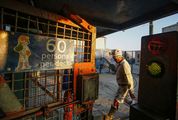Mystery and enchantment await in Chilean park
by Stephen Timm,
2016-02-05 05:00:00.0
OUT in Chiloé island’s national park it’s as if the entire world has disappeared and it’s just you — you and thousands of acres of forest and sea, the wind and your thoughts.
Most have never heard of Chiloé (or "place of the Seagulls", as it’s known in the language of the Huilliche, among the island’s first inhabitants). Yet it is possibly one of the world’s quaintest places.
Situated about 1,000km south of Chile’s capital Santiago, Chiloé lies at the gateway to arguably the country’s most attractive area, the lakes region. It’s what Tolkien’s mythical land the Shire from the Lord of the Rings would look and feel like if brought to realisation, for there is something mysterious about the place that draws you in.
From its attractive palafitos (colourful wooden homes on stilts) to its history of pirates and strange mythical creatures, to curato — the island’s traditional dish, a mix of seafood and meats — there’s something secretive and alluring to it all. It’s a kind of hideaway, made more so by the constant rain and mist that shroud the island. Even Charles Darwin, on a visit here in 1834 on the Beagle, commented that it was unlikely that there was a place with more rain on earth than on Chiloé. The island receives on average almost 2,000mm a year, with the park seeing about 3,000mm a year.
To get to the island, you must cross on one of the regular ferries to Chacao, on the northern side of the island close to Puerto Montt. Close by lies the island’s first settlement, Ancud (initially San Carlos), founded in 1767, and its fort, San Antonio.
Ancud’s narrow streets, conjure up the ambience of Ireland, while the town’s colourful wood shingled homes give it a Scandinavian air.
At the market, from vegetables and fruit, you can buy salmon, algae mashed into blocks, whole kelp tied together to look like offal and even self-published booklets detailing the local mythology.
The island’s capital Castro, 88km south of Ancud, is where you can spot the palafitos, grouped together in several neighbourhoods. When the tide recedes, the stilt homes are revealed in all their glory. Today, Castro is a busy market town, but when Darwin visited, he wrote that it was nearly deserted, with sheep grazing in the main plaza.
From Castro, you can catch buses to the national park and watch as lakes, sea and pastures slip by, and as Chilotes ease on and off at various waysides, greeting one another with a quiet, reserved joviality.
The park itself is situated near Cucao, where inhabitants once panned for gold on the river. Perhaps if you are lucky you can catch sight of the Trauco, a dwarf-like deformed creature. He’s more tokoloshe than hobbit, particularly as just like his South African cousin he’s known to attack and deflower the local women.
Over the small dunes that separate the wooded park from a wide grassy coastal plain, you can search for Pincoya, a woman known to emerge from the sea to dazzle fishermen. Legend has it that if she dances on the shore with her back to the sea it’s a sign of good times to come — that the next catch or crop will be plentiful. If her back faces the beach, the island is headed for hard times.
But out there on the grassy plain all I saw were horses, grazing away, hardly seeming to notice as I strode by to take a closer look at the torrent of waves. Had it been misty I may have sighted El Caleuche, the ghost ship that is known to appear on such days, carrying the island’s witches. But there was no such luck for me that day, mainly because it was unusually sunny.
Back in Ancud, I strolled west beneath elm-like trees towards the peninsula that juts out to form the protective bay in which the town lies.
Was it like this that Pedro Nancupel, a kind of Robin Hood character who was executed in Castro in 1888 for piracy and murder, saw the island? The mists are just lifting over the town when I tread out onto the pebbled beach, the water lazily lapping the coast. One might never know.

Stilt homes add to the glamour of Castro. capital of Chiloé Island in Chile. The national park is a bus ride away and may be one of the world’s quaintest places. Picture: SUPPLIED
OUT in Chiloé island’s national park it’s as if the entire world has disappeared and it’s just you — you and thousands of acres of forest and sea, the wind and your thoughts.
Most have never heard of Chiloé (or "place of the Seagulls", as it’s known in the language of the Huilliche, among the island’s first inhabitants). Yet it is possibly one of the world’s quaintest places.
Situated about 1,000km south of Chile’s capital Santiago, Chiloé lies at the gateway to arguably the country’s most attractive area, the lakes region. It’s what Tolkien’s mythical land the Shire from the Lord of the Rings would look and feel like if brought to realisation, for there is something mysterious about the place that draws you in.
From its attractive palafitos (colourful wooden homes on stilts) to its history of pirates and strange mythical creatures, to curato — the island’s traditional dish, a mix of seafood and meats — there’s something secretive and alluring to it all. It’s a kind of hideaway, made more so by the constant rain and mist that shroud the island. Even Charles Darwin, on a visit here in 1834 on the Beagle, commented that it was unlikely that there was a place with more rain on earth than on Chiloé. The island receives on average almost 2,000mm a year, with the park seeing about 3,000mm a year.
To get to the island, you must cross on one of the regular ferries to Chacao, on the northern side of the island close to Puerto Montt. Close by lies the island’s first settlement, Ancud (initially San Carlos), founded in 1767, and its fort, San Antonio.
Ancud’s narrow streets, conjure up the ambience of Ireland, while the town’s colourful wood shingled homes give it a Scandinavian air.
At the market, from vegetables and fruit, you can buy salmon, algae mashed into blocks, whole kelp tied together to look like offal and even self-published booklets detailing the local mythology.
The island’s capital Castro, 88km south of Ancud, is where you can spot the palafitos, grouped together in several neighbourhoods. When the tide recedes, the stilt homes are revealed in all their glory. Today, Castro is a busy market town, but when Darwin visited, he wrote that it was nearly deserted, with sheep grazing in the main plaza.
From Castro, you can catch buses to the national park and watch as lakes, sea and pastures slip by, and as Chilotes ease on and off at various waysides, greeting one another with a quiet, reserved joviality.
The park itself is situated near Cucao, where inhabitants once panned for gold on the river. Perhaps if you are lucky you can catch sight of the Trauco, a dwarf-like deformed creature. He’s more tokoloshe than hobbit, particularly as just like his South African cousin he’s known to attack and deflower the local women.
Over the small dunes that separate the wooded park from a wide grassy coastal plain, you can search for Pincoya, a woman known to emerge from the sea to dazzle fishermen. Legend has it that if she dances on the shore with her back to the sea it’s a sign of good times to come — that the next catch or crop will be plentiful. If her back faces the beach, the island is headed for hard times.
But out there on the grassy plain all I saw were horses, grazing away, hardly seeming to notice as I strode by to take a closer look at the torrent of waves. Had it been misty I may have sighted El Caleuche, the ghost ship that is known to appear on such days, carrying the island’s witches. But there was no such luck for me that day, mainly because it was unusually sunny.
Back in Ancud, I strolled west beneath elm-like trees towards the peninsula that juts out to form the protective bay in which the town lies.
Was it like this that Pedro Nancupel, a kind of Robin Hood character who was executed in Castro in 1888 for piracy and murder, saw the island? The mists are just lifting over the town when I tread out onto the pebbled beach, the water lazily lapping the coast. One might never know.




















Change: 2.60%
Change: 2.92%
Change: 4.80%
Change: 2.21%
Change: 2.84%
Data supplied by Profile Data
Change: 0.00%
Change: 0.00%
Change: 2.60%
Change: 0.00%
Change: 0.00%
Data supplied by Profile Data
Change: -0.01%
Change: 0.02%
Change: 0.09%
Change: 0.07%
Change: 0.00%
Data supplied by Profile Data
Change: 0.00%
Change: 0.00%
Change: 0.00%
Change: 0.00%
Change: 0.00%
Data supplied by Profile Data